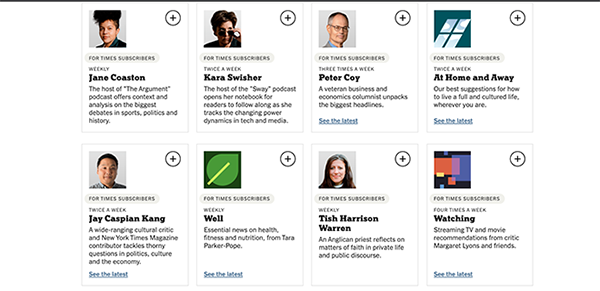 |
||||||||||
|
||||||||||
| NYT Goes All in on Tiered Newsletters |

Image sourced from the NYTimes
|
| The New York Times is banking on newsletters to continue elevating its subscriber base. Approximately one-third of its newsletters will be subscriber-only including columns from news and opinion writers like Jamelle Bouie, Paul Krugman, and Frank Bruni. Seven opinion newsletters will launch. “Writers include Times tech opinion columnist Kara Swisher; writer and sociologist Tressie McMillan Cottom; and Jay Caspian Kang, previously a writer-at-large at the New York Times Magazine. |
| The New York Times is providing a valued service to its readers; and by making a solid portion of its content behind a paywall, the company is hoping that its free content will lead readers to pay for related content for access to its variety of journalists. Plus this allows the company to compete with the likes of self-publishing platforms like Substack while emphasizing the bang for the buck readers will get subscribing to NYT vs individual self-published journalists for multiple, monthly rates. “If you think about the pricing power of individual newsletters right now, it’s still really nascent,” Alex Hardiman, chief product officer at the Times said. “You might for $15 or $20 be able to get three individual newsletters for a given month, whereas with us you can come and get a full subscriber newsletter portfolio and a full subscription for $17 a month. There’s real value in the bundle that we think people will see just because we can help address so many different needs in their news life.” This is also a way to keep digital subscriptions growing, now that many people are working again in an office setting that doesn’t double as a kitchen table. “In the short-term: publishers and marketers want to make sure they provide content and products in a way that keeps up with this trend,” Kerel Cooper, CMO of Liveintent told AdMonsters. “It’s sort of the next phase for these companies related to building engagement, interaction, and time spent with their brand. In the long-term: everyone understands that email will be the key to Identity in a first-party world. What these new entrants understand is the sheer superpower of the email address and they are developing strategies to be more dexterous with it.” |
| Third-Party Cookie Deprecation Is Coming Later; User-Agent String Deprecation Is Happening Sooner |
| Hold onto your hats marketers and publishers; while third-party cookie deprecation won’t occur now until 2023, user-agent deprecation has also been delayed but it won’t go into effect this year. Zach Edwards, Founder of Victory Medium, took to Twitter to break down how big this data supply change is, and how unprepared companies are. “Google is rolling out the UA-string deprecation in a 7-stage process, because this is easily the biggest data supply change on the internet, since the internet started,” he said. “There are entire ad tech systems from public companies operating their ‘anonymous, non-cookie syncing ad tech’ that rely on user-agent strings for maintaining a *huge* portion of their fingerprint graphs. W/ UA reduction, it's a value reduction - segments merged globally.” “And w/ Apple dropping their doubleblind IP address obfuscation tech, and user agent/fingerprinting vectors being deprecated from the browser level, and the potential for Google's gnatcatcher to launch - we're one step closer to technical "Privacy Budget APIs" in our flows.” |
| The UA string can be used by publishers and ad tech vendors to deter ad fraud, along with targeting and personalization. “Between now & the end of 2023, the ad tech data supply chains are seeing a reduction in segments & data used to maintain segments in such significant ways, it's like removing ethanol requirements from fuel blends,” said Edwards. “Supply chain shocks are going to be very hard to prevent.” With such drastic changes to the data supply change, web developers, rightfully so, are worried that the death of the UA string will, quite literally, break the internet. More so, many industry experts believe the death of the UA string is a bigger deal than saying goodbye to the third-party cookie. “The User-Agent is often part of fingerprinting. Some publishers use the data in the User-Agent, along with other information, to avoid serving bad impressions and determine when traffic is invalid,” said Aram Zucker-Scharff, Ad Engineering Director, RED, The Washington Post. “This is because the User-Agent leaks a lot of data about the system the page request is coming from and can contain information that makes it easy to identify as fraud. The loss of that user data for both good and bad actors will have a more significant impact than the current set of cookie changes. The ad fraud prevention industry continues to face challenges and this won’t help.” |
 |
| NPR Debuts Real-Time Diversity Tracker |
| NPR journalists can now track the demographics of their sources in real-time, thanks to the debut of Dex, short for Rolodex. When filing a story, journalists can now include a source’s race, gender identity, age range and geographic location. Sources can decline to give this information. This will help journalists tell stories that reflect the diversity of America by using sources who are equally diverse. Per Poynter: “NPR has been tracking the diversity of its sources since 2013. Before 2020, research teams at NPR took an annual random sample of the organization’s sources for their demographic analysis. …Just 28% of sources in 2013 were women, and 16% of expert sources were people of color. Twenty-seven percent of all sources came from Washington, D.C. Those numbers have since improved. In 2019, women made up close to 40% of all sources, and people of color made up 25 to 30% of expert sources. Less than 20% of sources came from Washington, D.C.” |
| NPR is talking the talk and walking the walk. The company spotted a problem and started implementing ways to correct it. The killing of George Floyd last year brought diversity and equality into the national spotlight (but it also resulted in loads of brand safety challenges for publishers). It also brought attention to companies and their company-wide DE&I strategies. Many brands and advertising agencies, like GroupM, Dentsu, Havas, Coca-Cola, McDonald’s, and General Motors, are investing in diverse voices; hopefully these same companies will invest, or continue to invest, in reverse news sources. Per Forbes: “The buying power of minority groups in the U.S. is exploding, totaling $4.2 trillion in 2020 and forecast to be $5.2 trillion in 2023… Nonetheless, support of minority owned media and their target audience has been sluggish. For example, Nielsen’s Ad Tel reports Black-owned media companies account for less than 2% of total ad dollars spent in 2020 despite accounting for 13% of the U.S. population.” |
| @{optoutfooterhtml}@ |












